Page
1 | Page 2 | Page 3 | Page
4 | Page 5 | Back
to Work Page
The
COs worked hard in the camps and according to newspaper their work
was appreciated. Report 1
50
years after the CO's service, In 1988, on the fiftieth anniversary
of the Sayward fire, Hon. Dave Parker, the Minister of Forests for
British Columbia, gave the following speech:
Good
afternoon Ladies and Gentlemen:
We
are standing beside the first forest in British Columbia to have
been raised from the ashes almost entirely by the hand of man.
This new Sayward Forest was planted, nurtured, and is growing
to maturity as a result of human effort.
Looking
at these stands of healthy, vigorous trees today, it is difficult
to imagine the scene of total devastation left after fire consumed
more than 30,000 hectares (75,000 acres) of this forest fifty
years ago.
The
first had been a major contributor to the local economy for many
years before the fire. Logging had started in 1889 with ox teams
skidding logs out to Elk Bay. The ox teams eventually gave way
to railway logging which was in turn replaced by tuck logging
in 1954. The gentle landscape in the Sayward area, along with
stands of prime timber, favoured relatively easy logging but also
created ideal conditions for the rapid spread of forest fires.
Logging practices of the time, which allowed slash to be left
on the ground, provided abundant fuel. Chances of a fire starting
in dry weather were always high near logging operations because
of sparks from steam engines and other equipment.
So
it was on July 5, 1938 when sparks from a yarding engine operating
just north of Campbell River started a fire in some felled trees.
The fire spread rapidly and within a short time it was apparent
that a major conflagration was under way. One newspaper account
of the time described it as a series of small infernos where old
snags burnt like candles on the devil's birthday cake.
Up
to the time of the Sayward fire, reforestation in British Columbia
and everywhere else in North America was accomplished mainly through
natural regeneration. However, it was realized that without a
massive artificial reforestation program, the Sayward would never
again be a productive forest. The idea of planting seedlings over
an area almost as big as Quadra Island was overwhelming in 1938.
The
problem wasn't just planting trees. The snags
had to be removed first before the trees could be planted. If
not, the snags would remain a fire hazard and threaten the new forest.
 David Jantzi talks about his job as a snag faller and why it was
important.
David Jantzi talks about his job as a snag faller and why it was
important.
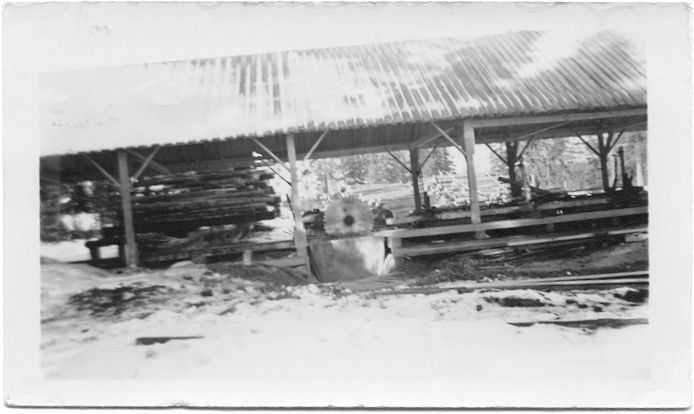 |
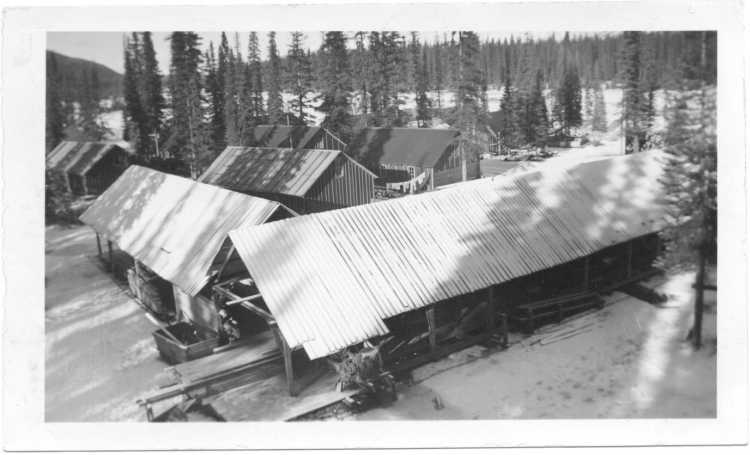 |
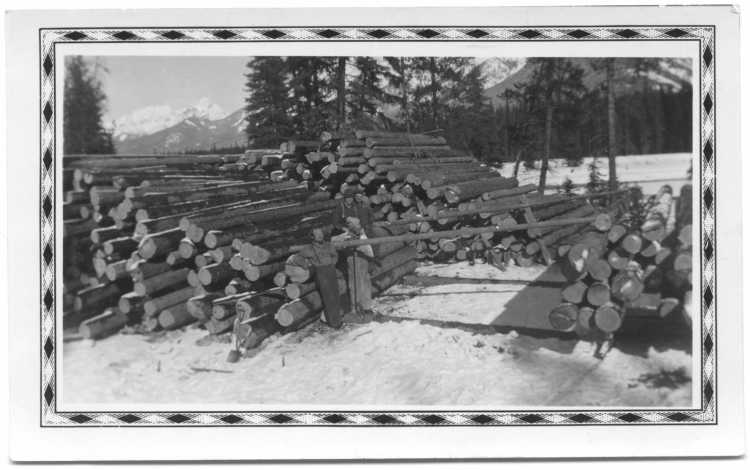 |
| A sawmill at a CO camp |
The saw mill at Camp 21, Radium, BC |
COs stacking logs near the sawmill |
Gordon
Dyck explains how the conscientious objectors removed the snags.
“Snagging
was a completely new experience for us prairie fellows. We always
worked in teams of two. Our tools were a six or seven crosscut
saw and a flask of diesel fuel to lubricate the saw if there was
a problem with pitch [sap]. Each of us had a falling axe which
was kept razor sharp.
First,
we always tried to determine which way the tree wanted to fall,
for if we were wrong, trouble was sure to follow. To force a tree
to go contrary to its inclinations was almost impossible with
our limited tools. It could have been done with a hammer and wedges,
but these were heavy and seldom carried. Sometimes we couldn't
tell which way a snag wanted to fall. To start with, every snag
had to have a substantial undercut to ensure safety in falling.
This was done with the axes, both men chopping alternately, so
it proceeded quite rapidly.
Once,
my partner Ike Neufeld and I were working on a snag that was about
three feet in diameter and about 10 feet [3 m] high where it had
broken off. It had no branches whatsoever. We proceeded to undercut
it on the correct side (we hoped), and then began to saw. After
sawing in a good distance we drove our axes into the cut to prevent
the tree from settling down on our saw – which it was sure to
do if we were wrong about its lean. After sawing to within an
inch of the undercut, we tried to force it to fall by prying with
our axes, but could not make it go. So we removed one handle from
the saw and drew it out so it wouldn't get broken if the tree
went backwards. Next we took our axes and cut the tree completely
off to let it go whichever way it preferred. But, strangely we
couldn't make it go backwards either. After trying for some time
to no avail, and wondering what to do next, the tree suddenly
started going backwards. I yelled a warning at Ike and he ran.
He had a very close call that day. Through some previous close
calls of my own, I had learned to keep looking up and taking a
few steps in the right direction. Sometimes when a tree fell into
another one, it could bend over and throw dry branches or tops
at us, so looking up was very important. [ASP, 61]
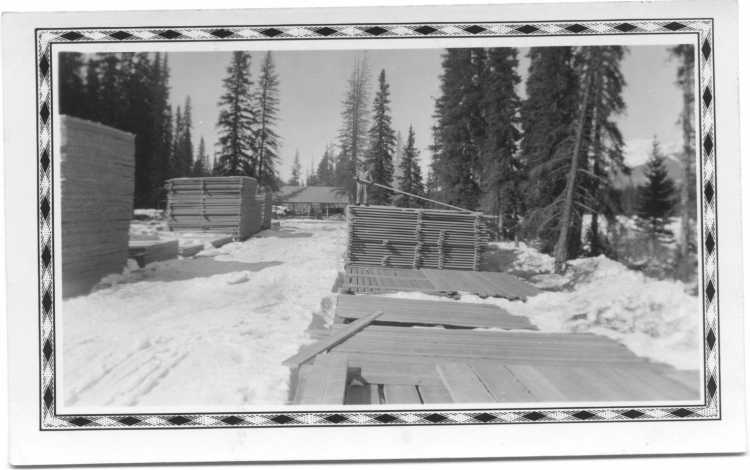 |
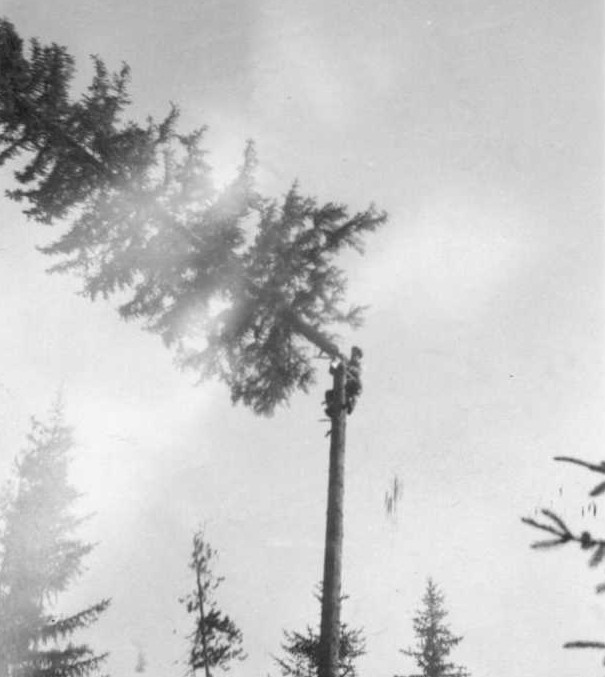 |
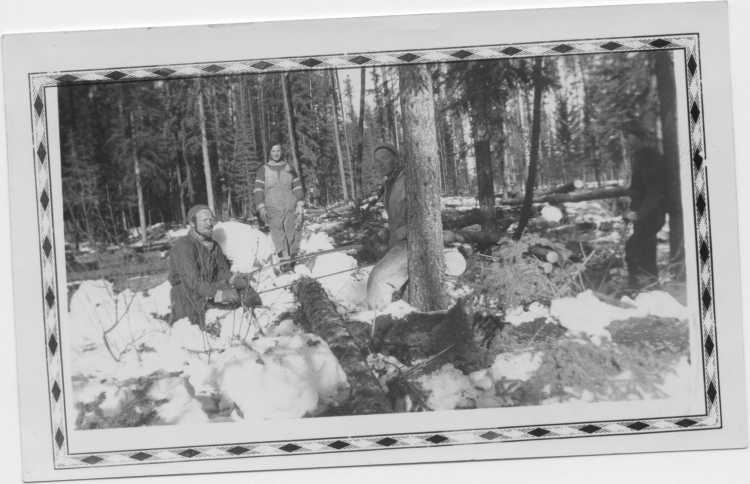 |
| Finished lumber from the sawmill |
"Topping" a tree |
COs sawing logs in the bush |
Page
1 | Page 2 | Page 3 | Page
4 | Page 5
| Back to Work Page |


